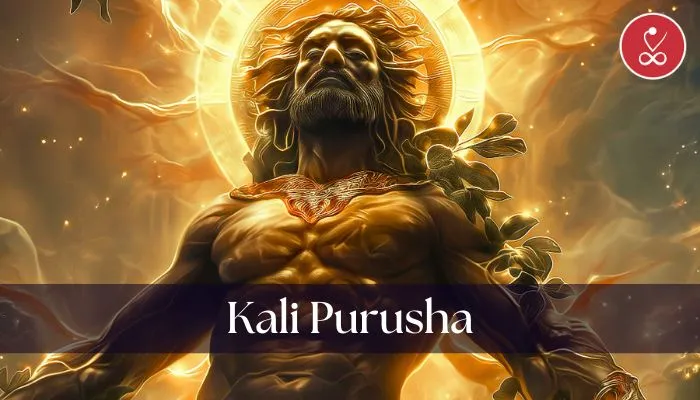Who is Kali Purusha?
The Yugas of Satya, Tetra, Dwapara, and Kali are the four cycles of time. Every Yuga has unique traits and follows a cycle. The best Yuga is Satya, when punishment is respected and work is pure.
As time passes, the essence of Satya becomes worse and reaches Tetra, Dwapara, and Kali, where people regularly experience evil. That final evilness in Kali Yuga is symbolised by Kali Purush.
Kali as Duryodhana
In reality. Duryodhana was the incarnation of Kali, and Dwapara, his companion, became his mama Sakuni. The donkey's cry on the day of his birth led Vidura, King Dhritarashtra's royal advisor and minister, to advise his King against keeping the child, but a father's love kept that from happening.
The story of Duryodhana went on to become one of Sanatani's greatest epics, the Mahabharata. Here too, Duryadhana's jealousy ended the Kauravas and Pandavas' lengthy war. After many brave soldiers sacrificed their lives, Sakuni was killed by Sahadeva, and Duryodhana was killed by Bhima.
Kali as Gandharva
Kali, a Gandharva, viewed himself as one of the strongest. He got angry when Damayanti, the daughter of Bhima (not Pandava), chose Nala as her wife over him and other gods like Agni, Yama, and Indra.
Twelve years passed before Kali launched his attack and joined the help of his friend Dwapara, a personification of Dwapara Yuga, to drive Nala from Nishadha's kingdom by tricking him into playing dice. Nala's brother Pushkara was successful, his father Nala as king, and Nala and his wife Damayanti went back to the forest.
Even in his life of exile, Kali's rage drove Nala away from Damayanti. As fate would have it, Nala—who carried Kali within him—became the ugly dwarf Bahuka, and Damayanti became the maiden of Princess of Chedi.
Bahuka was released from Kali's rule when he was named Charioteer of Ayodhya King Rituparna. Kali, the spirit, was vomited into a Vibhitaka tree by Nala. In his actual form, Nala went in search of his spouse, and Kali also believed his earlier form.

When will the Kali Purusha arrive on Earth?
The concept of "Kali Purusha" coming to Earth doesn't have a direct parallel in mainstream Hindu beliefs or scriptures. However, there are prophecies and beliefs in various Hindu traditions about the arrival of Kalki, the tenth and final avatar of the god Vishnu, who is expected to appear at the end of the current age, known as the Kali Yuga.
According to Hindu scriptures such as the Vishnu Purana and the Bhagavata Purana, Kalki is prophesied to come riding on a white horse wielding a sword to rid the world of evil and restore righteousness. The timing of Kalki's arrival is said to be towards the end of the Kali Yuga, the current age characterised by strife, degradation, and moral decline.
It's important to remember, though, that different Hindu traditions and scholars may have very different conclusions of these predictions and beliefs. Some take these prophecies as symbolic of personal spiritual development rather than an actual manifestation on Earth. Thus, there is confusion over the notion of a set time for Kalki's arrival.
Who is Kalki Avatar?
In Hinduism, Kalki is believed to be the tenth and final avatar (incarnation) of the god Vishnu, who is expected to appear at the end of the current age, known as the Kali Yuga. The concept of Kalki Avatar is mentioned in various Hindu scriptures, including the Vishnu Purana, the Bhagavata Purana, and the Kalki Purana.
Kalki is prophesied to come riding on a white horse, wielding a sword, to rid the world of evil and restore righteousness. His arrival is said to mark the end of the Kali Yuga, which is characterised by strife, degradation, and moral decline, and the beginning of a new golden age or Satya Yuga.
The details about Kalki Avatar's appearance and deeds vary in different texts and traditions. However, common themes include his role as a divine warrior and saviour, his ability to defeat evil forces, and his establishment of a new era of righteousness and harmony.
While the exact timing of Kalki's arrival is not specified in Hindu scriptures, it is generally believed to occur towards the end of the Kali Yuga. The idea of Kalki Avatar serves as a symbol of hope for the eventual restoration of dharma (righteousness) in the world.
Kalki Avatar (God) vs: Kali Purusha (Demon) - The War of God with Demon
The concept of a war between Kali Purusha and Kalki Avatar isn't explicitly mentioned in mainstream Hindu scriptures or mythology. Kali Purusha typically represents the destructive aspect of time, while Kalki Avatar is seen as the divine saviour who appears at the end of the Kali Yuga to restore righteousness.
While Hindu mythology does contain stories of battles between gods and demons, as well as prophecies about the final battle between good and evil, these narratives usually involve different sets of characters and contexts.
In Puranic literature, there's often a depiction of a cosmic battle known as the "Battle of Good and Evil" or the "Final Battle," where the forces of good, led by figures like Kalki Avatar or other divine incarnations, face off against the forces of evil. However, the adversary in these battles is typically portrayed as demonic forces or embodiments of evil rather than a specific entity like Kali Purusha.
It's important to note that Hindu mythology and philosophy contain a vast array of stories, interpretations, and allegorical representations, so while there may not be a direct mention of a war between Kali Purusha and Kalki Avatar in mainstream texts, there could be variations or interpretations within specific traditions or sects.